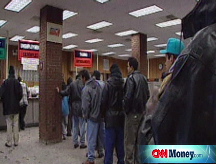The job market is worse than you think
The reported unemployment rate spiked to its highest level in more than 15 years. But some think the 'true' rate is really much higher.
NEW YORK (CNNMoney.com) -- The unemployment rate rose to 7.2% in December, the highest it has been since 1993. That's obviously not good news.
But the job market might be in even worse shape than this number suggests. There's a growing number of market experts who think that the government's employment statistics don't accurately paint the true picture of the job market.
In addition, many loyal readers of this column have expressed in both e-mails to me and comments in our Talkback section that they are frustrated with what they think is an intentionally distorted view of the job market.
Now to be fair, the government also does report a so-called underemployment rate, which includes some part-time workers as well as people who have given up looking for work during the past year. That figure is now 13.5%.
But one prominent critic, John Williams, an economist and publisher of the research site Shadowstats.com, said that when you take into account the large number of people who have been so discouraged by job market woes that they have not been actively looking for work for more than a year, the unemployment rate is actually as high as 17.5%
Williams explains that prior to 1994, all people who were "discouraged workers" were counted in the unemployment survey. But that's no longer the case. So he believes his number is more of an apples-to-apples comparison to some of the numbers cited about the peak level of unemployment during the Great Depression, which was around 25%.
What's more, Williams believes that this and other tweaks to the employment calculations over the past few decades were designed to give a more optimistic view of the economy.
"I think it's true that changes have made to make numbers look better. If you don't think the system is political, you don't know the system."
Now I don't know if I want to make this the financial equivalent of searching for a second shooter in the grassy knoll or alien remains in Roswell, N.M.
But I will admit that the government's labor numbers are, to put it mildly, flawed. Others agree.
"I will tell you that all models are wrong but not worthless. There is value to the unemployment number, even though it has its foibles," said Barry Ritholtz, CEO and director of equity research at research firm Fusion IQ and author of the soon-to-be-published book "Bailout Nation."
It goes without saying that even if you are willing to accept the 7.2% number as an accurate level of joblessness, the unemployment rate has shot up at an alarming rate in the past few months. It was 6.2% in September.
"We know we're in a recession and we know it got much worse over the past four months. Should anyone really be surprised by the job numbers?" Ritholtz said.
He predicts that the headline unemployment rate could go as high as 10% before the recession is over and that the "underemployment" figure could reach 16%
And there was more bad news in the December jobs report as well that didn't get as much attention as the 7.2% unemployment rate, 524,000 job losses for the month, or nearly 2.6 million jobs lost for the year.
Keep in mind that these are all lagging numbers. What's most important is trying to figure out what's next for the job market.
Along those lines, it's important to note that the average workweek declined from 33.5 hours in November to 33.3 hours in December. Brian Battle, vice president of Performance Trust Capital Partners, a fixed-income investment advisory firm in Chicago, said that spooked him more than other numbers.
"It looks like people that are still employed are working less," Battle said. "That portends more job cuts in the future. Companies might be keeping people now, but eventually will have to let them go if they are working less."
So with all this in mind, can President-elect Barack Obama's proposed stimulus package actually help to create jobs? Obama has promised to save or create 3 million jobs over the next two years.
Williams said the plan to create new jobs through increased spending on infrastructure could work...but at a cost.
"Stimulus could create some new jobs, but the problem is it will be very expensive. Washington thinks it can spend as much money as it can print," he said. "But there's no way it can borrow $2 trillion without seeing a sharp spike in money supply and inflation."
Are you unemployed and using unconventional methods to find work? Tell us about it, and you could be included in an upcoming story. ![]()






